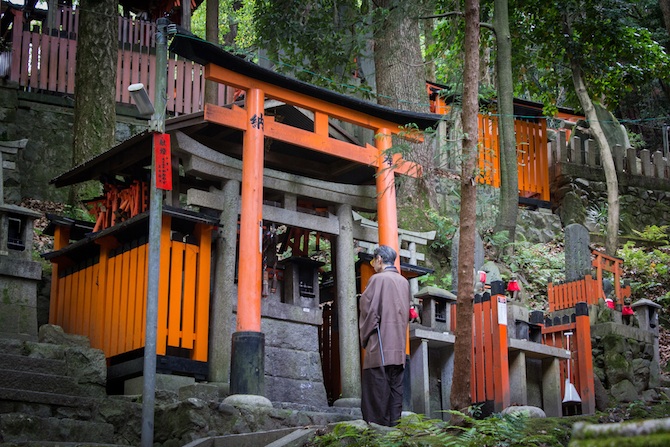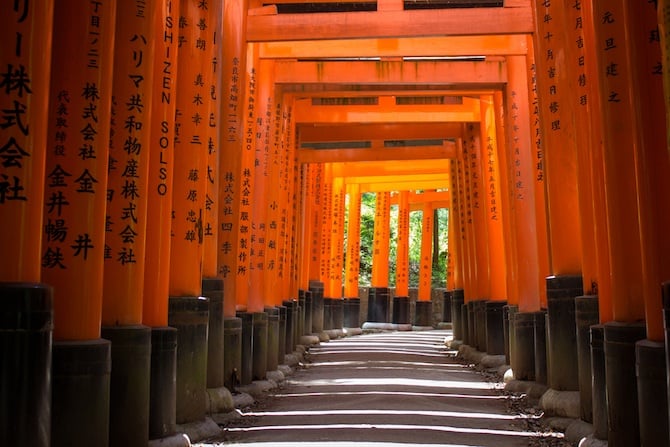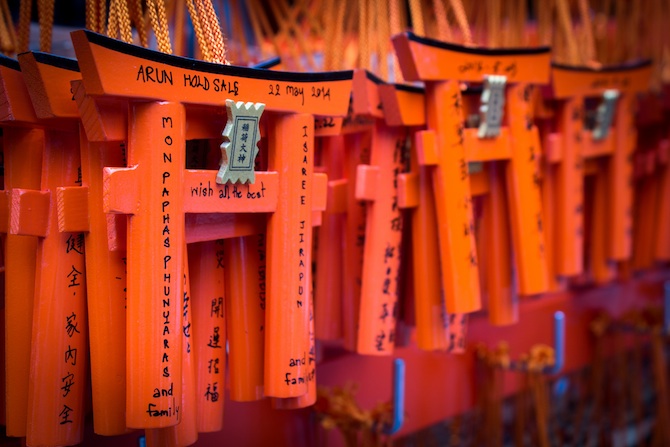Kyoto, Japan, is home to 17 UNESCO World Heritage Sites, one of which is the Fushimi Inari Taisha (Shrine) — not to mention the #1 Kyoto Attraction on TripAdvisor. You can reach the site — open daily from 7am to 6:30pm and a great budget-friendly travel experience as it offers free entrance — by taking the Nara Line on the Japan Railway System to Inari Station.

One of the many fox statues at Fushimi Inari Taisha Shrine.
In the eight century, the Hata Clan dedicated the Fushimi Inari Taisha Shrine In Kyoto, Japan, to the god of rice, sake and, nowadays, business prosperity. This is one reason you’ll see so many fox statues and souvenirs around the site, as foxes are believed to be the messengers of Shinto God Inari, and you’ll notice many holding keys to the rice granary in their mouths.
My local guide English-speaking guide Michiko Moriwaki — if you need a guide you can contact her at moriwaki.michiko (at) gmail (dot) com — explained to me that foxes eat rats and rabbits — two animals that eat and destroy the harvest, and then excrete them as fertilizer, which is good for the harvest. This is a major reason why they are worshiped at this temple, as is the fact many Japanese believe having one fox statue at either side of a door keeps evil from coming inside.

Fushimi Inari Taisha Shrine.
There’s so much to see and you could easily spend over four hours exploring the offerings of the religious site. There are numerous opportunities for making wishes for the future — like ringing giant bells and writing on small woodentorii gates — as well as opportunities to have your fortune read by choosing oracles at random and purchasing an amulet to ward off evil spirits.

The torii-lined pathway at Fushimi Inari-taisha Shrine.
One can also hike to the top of a mountain in a unique way. From the entrance of the Shinto shrine to the summit of Mount Inari one will gain an elevation of about 550 feet (168 meters) — the mountain is 765 fee/233 meters high) — with 5,000 vermilion torii gates lining the paths. If you’ve ever seen the movie “Memoirs of a Geisha,” they show the pathway with a girl sprinting through the arches. The trail is about 2.5 miles (4 kilometers) round trip, and worth it for the surreal experience of walking under the bright-colored entryways the whole time and the small shrines you’ll find along the way. Aerial Kyoto city views are also part of the excitement.

If you don’t have $15,000 to spare, you can also purchase a small torii gate to inscribe.
The torii are sponsored by local businesses, and you can see their inscriptions wishing for the prosperity of their business. Costs vary depending on the size of the torii; however, the largest and most expensive are about $15,000 USD. Luckily for those who don’t have a mortgage payment to blow, there are small wooden torii ornaments one can buy for about $5 to write heir names and wishes.
Have you visited Fushimi Inari Taisha Shrine? What was your most memorable experience? Please share in the comments below.
My trip to Japan’s Kansai Region was sponsored by the Japan National Tourism Organization. I was not required to write this post nor was I compensated for it. All opinions are 100% my own.
Top photo credit: Jessica Festa, all other photos courtesy: Simon Q.

Jessica Festa is the editor of the travel sites Jessie on a Journey (http://jessieonajourney.com) and Epicure & Culture (http://epicureandculture.com). Along with blogging at We Blog The World, her byline has appeared in publications like Huffington Post, Gadling, Fodor’s, Travel + Escape, Matador, Viator, The Culture-Ist and many others. After getting her BA/MA in Communication from the State University of New York at Albany, she realized she wasn’t really to stop backpacking and made travel her full time job. Some of her most memorable experiences include studying abroad in Sydney, teaching English in Thailand, doing orphanage work in Ghana, hiking her way through South America and traveling solo through Europe. She has a passion for backpacking, adventure, hiking, wine and getting off the beaten path.








